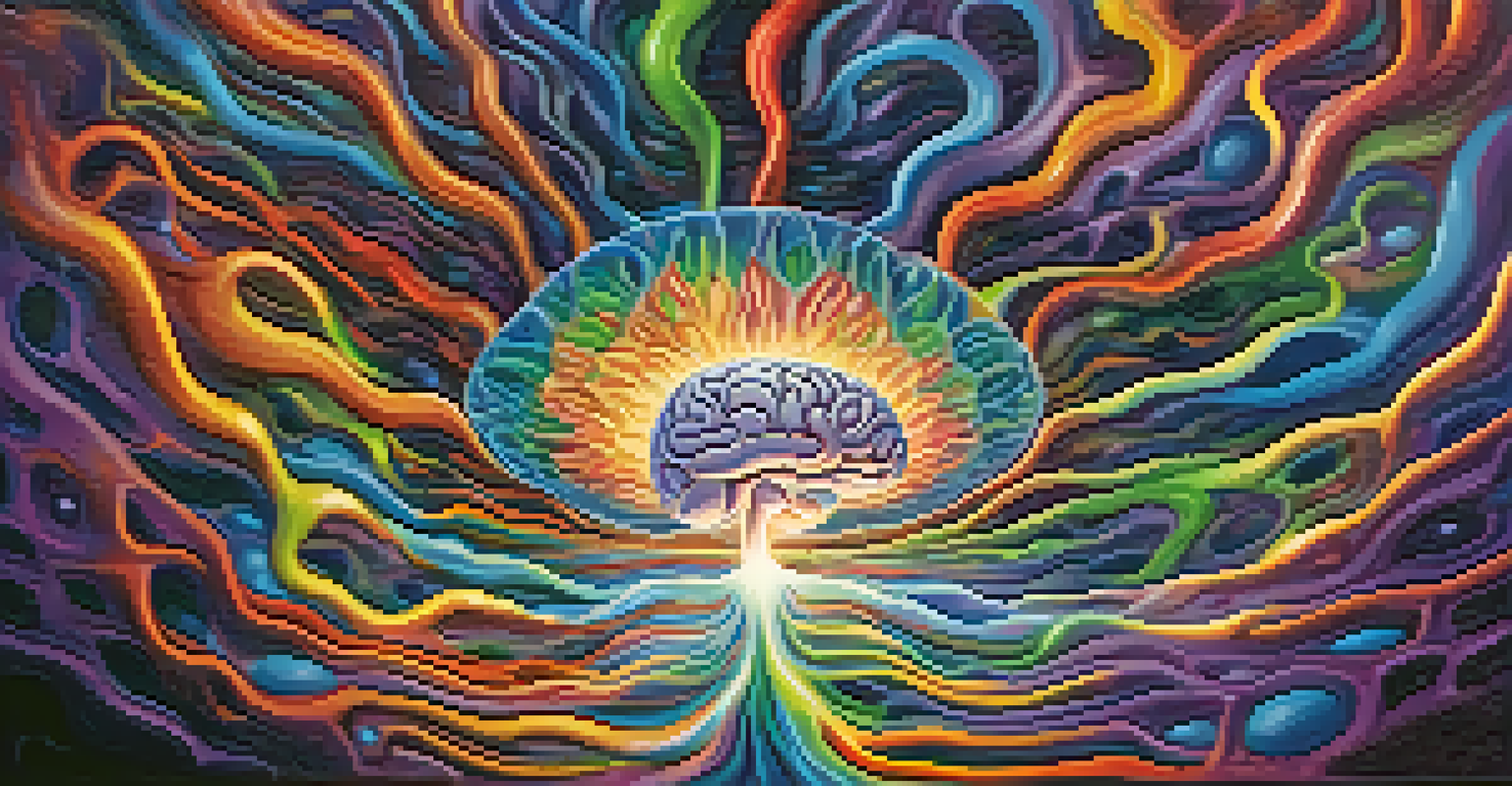Entheogens in Treating Addiction: Future Research Avenues

Understanding Entheogens: A Brief Overview
Entheogens are substances that can induce altered states of consciousness, often used in spiritual or therapeutic contexts. Common examples include psilocybin, found in certain mushrooms, and ayahuasca, a brew made from Amazonian plants. These substances have been utilized for centuries in various cultures, primarily for introspection and healing.
Psychedelics are not a panacea, but they can offer profound healing when used responsibly in a therapeutic context.
The resurgence of interest in entheogens has sparked curiosity in their potential therapeutic applications, particularly in treating addiction. Researchers are keen to explore how these substances can facilitate deep psychological insights and emotional healing. This exploration marks a shift from traditional treatment methods, which often focus solely on behavioral modification.
As addiction remains a pressing public health issue, understanding how entheogens work can offer new avenues for effective treatment. By tapping into the mind's potential for healing, there’s hope for individuals seeking a path away from substance dependence.
Current Research on Entheogens and Addiction
Recent studies have begun to shed light on the effects of entheogens on addiction recovery. For instance, research has shown that psilocybin can significantly reduce cravings in people with alcohol use disorder. Participants often report profound experiences that help them re-evaluate their relationship with substances, leading to lasting behavioral changes.

In addition to psilocybin, substances like MDMA and ketamine are also being examined for their potential in treating addiction. These substances are thought to create a sense of emotional openness, allowing individuals to confront underlying issues related to their addiction. The therapeutic setting enhances the experience, providing a safe space for exploration and healing.
Entheogens Aid Addiction Recovery
Research shows that substances like psilocybin and MDMA can significantly reduce cravings and promote emotional healing in individuals struggling with addiction.
While these findings are promising, it's essential to approach the research with caution. The effects of entheogens can vary greatly from person to person, and further studies are necessary to understand their long-term impact on addiction.
Mechanisms of Action: How Entheogens Work
Entheogens primarily affect the brain's serotonin receptors, which play a crucial role in mood regulation and emotional processing. By altering neurotransmitter activity, these substances can lead to heightened emotional experiences and increased introspection. This shift can help individuals confront and process traumas that contribute to their addiction.
The experience of interconnectedness and empathy that entheogens can provide may help individuals break the cycle of addiction.
Moreover, entheogens can foster a sense of interconnectedness and empathy, potentially reducing feelings of isolation often experienced by those struggling with addiction. This newfound perspective can empower individuals to seek support from others and build healthier relationships. It's akin to shedding a heavy coat and feeling the warmth of community for the first time.
Understanding these mechanisms is vital for researchers. It allows them to tailor treatment protocols and create supportive environments that enhance the efficacy of entheogen-assisted therapy.
Ethical Considerations in Entheogen Research
As research into entheogens expands, ethical considerations must be at the forefront. Ensuring informed consent, where participants fully understand the potential risks and benefits, is crucial. This is especially important given the profound experiences these substances can induce, which may be overwhelming for some individuals.
Additionally, the societal stigma surrounding drug use can complicate perceptions of entheogen research. It’s essential to communicate that these substances are being studied for therapeutic purposes, not recreational use. Educating the public can help shift the narrative and encourage a more open-minded approach to addiction treatment.
Ethical Research is Crucial
Ensuring informed consent and addressing societal stigma are essential for the responsible study and application of entheogens in therapeutic settings.
Lastly, the potential for misuse or misinterpretation of entheogen-assisted therapy raises concerns. Rigorous research protocols and clinical trials are necessary to establish safe and effective treatment guidelines.
Challenges Facing Entheogen Research
Despite the promising results, research on entheogens faces several challenges. One significant hurdle is the legal status of many of these substances, which can vary by region and hinder research efforts. In some places, strict regulations limit access to these compounds, making it difficult to conduct comprehensive studies.
Another challenge lies in the variability of individual responses to entheogens. Factors such as dosage, set (mindset), and setting (environment) play crucial roles in determining the outcomes of experiences. This variability complicates the development of standardized treatment protocols that could be widely applicable.
Moreover, funding for entheogen research can be limited. Many traditional funding sources may be hesitant to support studies involving substances that have historically been associated with recreational use. Overcoming these challenges will be essential for advancing our understanding of entheogens in addiction treatment.
Future Directions in Entheogen Research
Looking ahead, researchers aim to explore the long-term effects of entheogen-assisted therapy on addiction recovery. Understanding how these treatments can impact individuals months or even years after their experiences is crucial for evaluating their effectiveness. This longitudinal approach can provide valuable insights into the sustainability of recovery.
Additionally, there is growing interest in combining entheogens with traditional therapeutic modalities, such as cognitive-behavioral therapy (CBT). This integrative approach could enhance treatment outcomes by addressing both the psychological and emotional aspects of addiction. Imagine a holistic treatment plan that combines the best of both worlds.
Future of Treatment is Promising
Combining entheogens with traditional therapies could enhance addiction treatment outcomes and foster long-term recovery.
Finally, continued advocacy for policy reform is vital. By promoting the therapeutic potential of entheogens, researchers can help shift public perception and pave the way for more inclusive treatment options for addiction.
Conclusion: A New Era in Addiction Treatment
The exploration of entheogens in treating addiction marks a significant shift in the approach to recovery. As research continues to unveil the potential benefits, there's an opportunity to rethink traditional methods and embrace innovative healing practices. This could lead to more compassionate and effective treatment options for individuals facing addiction.
By understanding the mechanisms behind entheogens and addressing ethical considerations, researchers can create safe, supportive environments for therapeutic use. The aim is not just to treat addiction but to foster lasting change and personal growth.

In essence, the future of addiction treatment may very well lie in the depths of the human mind, guided by the healing properties of entheogens. This journey of exploration holds the promise of hope for many.